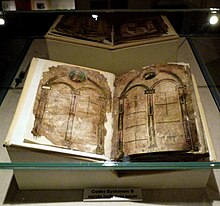Eyckensis法典
此條目翻譯品質不佳。 (2017年3月24日) |
8世紀的《Eyckensis法典》是以2本組成手稿為基礎的福音書,據推測這2本手稿形成了12世紀至1988年的卷軸。
《Eyckensis法典》是比利時最古老的書籍[1]。自8世紀起它便一直被保存在當今馬澤克(Maaseik) 轄區的領土上,因此得名「Eyckensis」。此書可能創作於埃希特納赫修道院的書桌上。
手稿A與手稿B的描述
[編輯]Eyckensis法典由133張對開羊皮紙上的兩本傳道書組成,每張羊皮紙的尺寸為244*183毫米。

第一本手稿(法典A)不完整。它由5張對開紙組成,開頭是一全頁的傳道者肖像(據推測是描畫的聖馬修),之後是一組不完整的八張教規表。福音傳教士的肖像以義大利 - 拜占庭風格呈現,這明顯與當前保存在梵蒂岡圖書館的巴貝里尼福音書(Barberini Lat. 570)有關。肖像畫的邊框是盎格魯 - 撒克遜結,相當於林迪斯芳福音書的裝飾元素。
教規表提供了四本福音書中相應段落的概述。其可作為教規表的目錄和索引,以便於查閱文本。手稿A中的教規表裝飾有圓柱和拱廊,以及四位福音傳教士的符號和聖人的肖像。
第二本手稿(法典B)包含整套的12張教規表和所有4本福音文本。教規表中的裝飾有圓柱和拱廊,以及使徒的描述和福音傳教士的符號。福音文本是以圓形小寫字母寫成的,這是7世紀與8世紀時英國與愛爾蘭手稿的特點,但也在歐洲大陸使用。每個段落的首個大寫字母用紅色和黃色圓點勾畫。 文本由一個抄寫員抄寫。
福音文本是拉丁文聖經的一版,大多由聖傑羅姆翻譯(聖哲羅姆,公元347年-420年),並有幾次添加和變換。福音文本的類似版本可在《凱爾經》(都柏林,三一學院,第58期)、《阿爾馬經》(都柏林,三一學院,第52期)和《埃希特納赫福音》(巴黎國家圖書館,第 Lat.9389期)中找到。
歷史(從起源到20世紀)
[編輯]
法典可以追溯到8世紀,最初被保存在原來的Aldeneik本尼迪克特修道院,該修道院於公元728年祝聖。Merovingian貴族德南之王Adelard和妻子Grinuara為他們的女兒Harlindis和Relindis在Meuse河附近的「小而無用的樹林」中[2]創建了這所修道院。 修道院因在那裡生長的橡樹而被命名為Eyke(「橡樹」)。 後來,隨著鄰近的Nieuw-Eyke村(「新橡樹」 - 當前的Maaseik)的發展,且變得更加重要,原來的村莊的名字變成了Aldeneik(「老橡樹」)。 聖威利布羅德將Harlindis祝聖為該宗教區的第一位女修道院院長。 在她死後,聖博尼法斯將她的妹妹Relindis祝聖為她的繼任者。
在修道院中使用Eyckensis法典進行研究,並用於傳播基督的教導。 據推測現在構成Eyckensis法典的兩本福音書是由聖威利布羅德從埃希特納赫修道院帶到了Aldeneik。
兩本手稿最有可能在12世紀時整合成了一本書。1571年,Aldeneik修道院被廢棄了。從10世紀中葉起,本篤會尼姑被男性教士所取代。伴隨著宗教戰爭日益嚴重的威脅,教士們在Maaseik的城鎮中避難。他們將教堂的珍寶——包括Eyckensis法典——從Aldeneik帶到了聖凱薩琳教堂。
作者身份
[編輯]
幾個世紀以來,人們一直相信Eyckensis法典是由Harlindis 和 Relindis著成的,她們是Aldeneik修道院的首位修道院院長,之後被封為聖徒。一位當地的牧師在9世紀時寫下了她們的聖徒言行傳[3]。文中提到Harlindis和Relindis也寫作了傳道福音。9世紀時聖徒姐妹的遺物變得越來越重要, Eyckensis法典獲得了越來越多的尊重,因其是Harlindis 和Relindis的著作得到了極大的尊重。[2]
然而,第二本手稿的最後幾行明確反駁道:Finito volumine deposco ut quicumque ista legerint pro laboratore huius operis depraecentur (在此卷完成之時,我請所有讀者為製作此手稿的工人祈禱)。Laborator(「工人」)詞性為男性,明確表明手稿的作者為男性。
1994年,由Albert Derolez(根特大學)和Nancy Netzer(波士頓學院)進行的比較分析表明,手稿A和手稿B追溯於同一時期,兩者都很可能是在埃希特納赫修道院創作的,它們甚至可能由同一位抄寫員完成[4]。
1957年進行的保護和修復嘗試
[編輯]1957年,來自杜塞道夫的修復者Karl Sievers試圖保護並修復Eyckensis法典。他移除並銷毀了18世紀紅色天鵝絨封面,之後用Mipofolie層壓手稿的所有對開頁。Mipofolie是聚氯乙烯(PVC)箔,用鄰苯二甲酸二辛酯外部增塑。隨著時間的流逝,該箔產生鹽酸,侵蝕羊皮紙並且對箔本身具有黃化效應。 羊皮紙的透明度和顏色受到影響,存在於箔中的聚合物可遷移到羊皮紙上並使其變脆。在層壓之後,Sievers重新裝訂了法典。為了能夠這樣做,他切開了對開頁的邊緣,這導致彩飾的碎片丟失。

在1987年至1993年間進行的一次新的大規模修復工作中,在化學家Jan Wouters博士的領導下,比利時皇家文化遺產研究所的一個團隊精心刪除了Mipofolie層壓。在去除層壓板之後對對開紙的恢復中,開發了創新的羊皮紙片播技術。 為了完成恢復工作,法典的兩個組成手稿分別裝訂[5]。
存檔和數位化
[編輯]Eyckensis法典最古老的影像文件起源於約1916年(Bildarchiv Marburg(頁面存檔備份,存於網際網路檔案館))。在修復過程時,比利時皇家文化遺產研究所(KIK-IRPA)對手稿進行了拍攝。 1994年出版了一份傳真[6]。
2015年,Eyckensis法典在聖凱薩琳教堂的網站上數位化,由成像實驗室和Illuminare——中世紀藝術研究中心|KU Leuven 完成。此項目由Lieve Watteeuw教授[7]領導。與LIBIS(KU Leuven)合作在線獲得高解析度圖像。
1986年,Eyckensis法典被認定為不可移動遺產並獲得保護。2003年Eyckensis法典被公認為佛蘭芒傑作(頁面存檔備份,存於網際網路檔案館)。
當前研究
[編輯]2016-2017年間,來自Illuminare -中世紀藝術研究中心|KU Leuven(Lieve Watteeuw教授)和比利時皇家文化遺產研究所(Marina Van Bos博士)的團隊將再次研究Eyckensis法典。
欲了解更多信息,請查閱:
- www.codexeyckensis.be(頁面存檔備份,存於網際網路檔案館)
- Lab-KU Leuven遺產書籍(頁面存檔備份,存於網際網路檔案館)
- 比利時皇家文化遺產研究所-(頁面存檔備份,存於網際網路檔案館)(KIK–IRPA)
參考資料
[編輯]- ^ Coenen, J., Het oudste boek van België, Het Boek 10, 1921, S. 189-194.
- ^ 2.0 2.1 Acta Sanctorium, Martii, unter Leitung von J. Carnandet, 3. Teil, Paris-Rom, 1865, S. 383-390, Abs. 7.
- ^ Abbaye d』Aldeneik, à Maaseik, in Monasticon belge, 6, Province de Limbourg, Lüttich, 1976, S. 87.
- ^ Netzer, N.(1994) Cultural Interplay in the Eighth Century. The Trier Gospels and the Making of a Scriptorium at Echternach, Cambridge-New York.
- ^ Wouters, J., Gancedo, G., Peckstadt, A., Watteeuw, L. (1992). The conservation of the Codex Eyckensis: the evolution of the project and the assessment of materials and adhesives for the repair of parchment. The Paper Conservator 16, 67-77. http://www.tandfonline.com/doi/abs/10.1080/03094227.1992.9638578
- ^ Coppens, C. , A. Derolez und H. Heymans (1994) Codex Eyckensis: an insular gospel book from the abbey of Aldeneik. Maaseik: Museactron.
- ^ https://www.arts.kuleuven.be/english/news/codex eyckensis
外部連結
[編輯]- The Codex Eyckensis on www.codexeyckensis.be(頁面存檔備份,存於網際網路檔案館)
- The Codex Eyckensis, online high-resolution images on LIBIS(頁面存檔備份,存於網際網路檔案館)
- The Codex Eyckensis on Erfgoedplus(頁面存檔備份,存於網際網路檔案館)
- The Codex Eyckensis on www.museamaaseik.be(頁面存檔備份,存於網際網路檔案館)
- The Codex Eyckensis on Europeana
- The Codex Eyckensis in the early 20th century in the Marburg Bildarchiv(頁面存檔備份,存於網際網路檔案館), Deutsches Dokumentationszentrum für Kunstgeschichte
- The Codex Eyckensis before and after the restoration in the late 20th century, on the Royal Institute for Cultural Heritage website(頁面存檔備份,存於網際網路檔案館)
Bibliography
[編輯]Coenen, J. (1921) Het oudste boek van België, Het Boek 10, pp. 189-194.
Coppens, C., A. Derolez en H. Heymans (1994) Codex Eyckensis: an insular gospel book from the abbey of Aldeneik, Antwerpen/Maaseik, facsimile.
De Bruyne, D. (1908) L'évangéliaire du 8e siècle, conservé à Maeseyck, Bulletin de la Société d'Art et d'Histoire du Diocèse de Liège 17, pp. 385-392.
Dierkens, A. (1979) Evangéliaires et tissus de l』abbaye d』Aldeneik. Aspect historiographique, Miscellanea codicologica F. Masai Dicata (Les publications de Scriptorium 8), Gent, pp. 31-40.
Falmagne, T. (2009) Die Echternacher Handschriften bis zum Jahr 1628 in den Beständen der Bibliothèque nationale de Luxembourg sowie Archives diocésaines de Luxembourg, der Archives nationale, der Section historique de l' Institut grand-ducal und des Grand Séminaire de Luxembourg, Wiesbaden, Harrassowitz Verlag, 2 Banden: 311pp. + [64] ill., 792pp.
Gielen J. (1880) Le plus vieux manuscrit Belge, Journal des Beaux-Arts et de la Littérature 22, nr. 15, pp. 114-115.
Gielen, J. (1891) Evangélaire d'Eyck du VIIIe siècle, Bulletin Koninklijke Commissie voor Kunst en Oudheden 30, pp. 19-28.
Hendrickx, M. en W. Sangers (1963) De kerkschat der Sint-Catharinakerk te Maaseik. Beschrijvende Inventaris, Limburgs Kunstpatrimonium I, Averbode, pp. 33-35.
Mersch, B. (1982) Het evangeliarium van Aldeneik, Maaslandse Sprokkelingen 6, pp. 55-79.
Netzer, N. (1994) Cultural Interplay in the 8th century and the making of a scriptorium, Cambridge, Cambridge University Press, 258pp.
Nordenfalk, C. (1932) On the age of the earliest Echternach manuscripts, Acta Archeologica, vol. 3, fasc. 1, Kopenhagen: Levin & Munksgaard, pp. 57-62.
Schumacher, R. (1958) L』enluminure d』Echternach: art européen, Les Cahiers luxembourgeois, vol. 30, nr. 6, pp. 181-195.
Spang, P. (1958) La bibliothèque de l』abbaye d』Echternach, Les Cahiers luxembourgeois, vol. 30, nr. 6, pp. 139-163.
Talbot, C.H. (1954) The Anglo-Saxon Missionaries in Germany. Being the Lives of SS. Willibrord, Boniface, Sturm, Leoba and Lebuin, together with the Hodoeporicon of St. Willibald and a selection of the Correspondence of Boniface, [vertaald en geannoteerd], Londen-New York, 1954, 234pp.
Verlinden, C. (1928) Het evangelieboek van Maaseik, Limburg, vol. 11, p. 34.
Vriens, H. (2016) De Codex Eyckensis, een kerkschat. De waardestelling van een 8ste eeuws Evangeliarium in Maaseik, onuitgegeven master scriptie Kunstwetenschappen, KU Leuven.
Wouters, J., G. Gancedo, A. Peckstadt, en L. Watteeuw, L. (1990) The Codex Eyckensis: an illuminated manuscript on parchment from the 8th century: Laboratory investigation and removal of a 30 year old PVC lamination, ICOM triennial meeting. ICOM triennial meeting. Dresden, 26-31 August 1990, Preprints: pp. 495–499.
Wouters, J., G. Gancedo, A. Peckstadt en L. Watteeuw (1992) The conservation of the Codex Eyckensis: the evolution of the project and the assessment of materials and adhesives for the repair of parchment, The Paper Conservator 16, pp. 67-77.
Wouters, J., A. Peckstadt en L. Watteeuw (1995) Leafcasting with dermal tissue preparations: a new method for repairing fragile parchment and its application to the Codex Eyckensis, The Paper Conservator 19, pp. 5-22.
Wouters, J., Watteeuw, L., Peckstadt, A. (1996) The conservation of parchment manuscripts: two case studies, ICOM triennial meeting, ICOM triennial meeting. Edinburgh, 1-6 September 1996, London, James & James, pp. 529-544.
Wouters, J., B. Rigoli, A. Peckstadt en L. Watteeuw, L. (1997) Un matériel nouveau pour le traitement de parchemins fragiles, Techné: Journal of the Society for Philosophy and Technology, 5, pp. 89-96.
Zimmerman, E.H. (1916) Vorkarolingische Miniaturen, Deutscher Verein für Kunstwissenschaft III, Sektion, Malerei, I. Abteilung, Berlin, pp. 66-67; 128; 142-143, 303-304.
